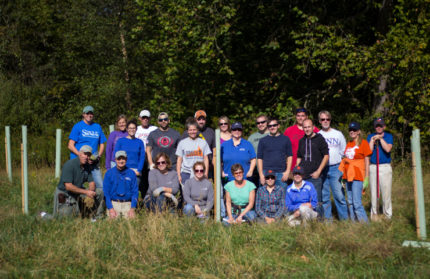50 Years of Fresh Water
Photos: Tara Muenz, Kay Dixon, Nick Media ProductionsStroud Center Builds Clean Water Legacy Along White Clay Creek.
 The 50-year history of Stroud Water Research Center begins and continues to this day on the banks of White Clay Creek in southern Chester County.
The 50-year history of Stroud Water Research Center begins and continues to this day on the banks of White Clay Creek in southern Chester County.
Today, the Stroud Center is an independent 501(c)(3), not-for-profit, non-advocacy organization recognized worldwide as much for environmental education and watershed restoration as for freshwater science. However, 50 years ago, it opened as a field station of the Academy of Natural Sciences of Philadelphia. The mission—to understand how natural streams and rivers work in an effort to preserve clean and healthy waterways and restore polluted ones—came from founders Ruth Patrick, Ph.D., an eminent freshwater ecologist at the academy, and philanthropists Dick and Joan Stroud, friends of Patrick.
One of the Stroud Center’s first contributions to science and to the ecological value of the region came early on in 1969 when the Rockefeller Foundation awarded it a five-year grant to gather data on nearly every aspect of stream life in the White Clay Creek watershed, a 100-square-mile patch in southeastern Pennsylvania and northern Delaware. The study expanded our understanding of how streams react to stress from both natural disturbances and human activities.
Out of that work and the research that continues to this day, Stroud Center scientists have identified ways to help citizens in southeastern Pennsylvania and beyond better protect and manage the fresh water that flows through their public and private lands.
Two ways to accomplish those efforts are through planting streamside forest buffers and developing citizen education programs. And both are open to the public.
Our National Treasures Need the Protection of Trees
Sadly, scientists estimate close to half of Pennsylvania’s streams and rivers are moderately to severely impaired, and about 20 percent are in such poor condition they fail to meet sufficient water-quality standards under the Clean Water Act. The good news is that White Clay Creek is not in that failing group. In fact, White Clay Creek is better protected against stormwater runoff, erosion and pollution today than it was 50 years ago.
This improved protection is thanks in part to the Stroud Center, along with local partners and volunteers who plant trees along the White Clay Creek banks, creating 100-foot buffers. Tree cover within the watershed has more than doubled since the Stroud Center’s founding in 1967.
In a 2016 report, the University of Delaware noted, “The White Clay Creek watershed is one of only a few relatively intact, unspoiled and ecologically functioning river systems remaining in the highly congested and developed corridor linking Philadelphia Pennsylvania, with Newark, Delaware.”
In fact, the headwaters of the East Branch of White Clay Creek are generally the healthiest reaches in the watershed, providing a variety of habitats that support rich biodiversity: 21 species of fish, 33 species of small mammals, 27 species of reptiles and amphibians, over 200 species of breeding and migratory birds, and over 300 species of aquatic insects.
In 1984, Pennsylvania named the East Branch an Exceptional Value Stream, its highest water-quality designation, and in 2000, federal legislation named White Clay Creek and its tributaries a National Wild and Scenic River, signifying its outstanding scenic, wildlife, recreational and cultural value. That marked the first time an entire watershed—rather than just a section of river—had been so named.
 Next Gen Citizen Scientists
Next Gen Citizen Scientists
Almost 30 years ago, Bud Rocky’s ninth-grade science class at nearby Upland Country Day School marked the launch of the Stroud Center’s first education program. The concept was simple: The students placed small mesh bags filled with leaves into White Clay Creek. Critters that ate the leaves revealed in part the health of the stream based on species type and diversity.
The Leaf Pack Experiment, as it became known, expanded to local schools, and over the next several years Stroud Center educators got the kits into the hands of science teachers throughout Pennsylvania, creating a generation of citizen scientists. Last year, the Stroud Center engaged more children and adults in face-to-face programs than in any previous year: about 5,800, or about triple the number in 2015.
“A big part of the draw for students and teachers who come to the Stroud Center is that we are connecting them to scientific research while exploring nature,” says Education Director Steve Kerlin, Ph.D. “It’s a sensory experience as well as an educational experience.”
Executive Director Dave Arscott, Ph.D., says, “This is science making a measurable positive change for both people and planet. What could be better?”
Stroud Water Research Center, based in Avondale, advances global freshwater research, environmental education and watershed restoration. The nonprofit organization helps everyone make informed decisions that affect water quality and availability around the world. More at StroudCenter.org.
Want to Save Streams? Get Involved!
September 20: Science Seminar Series
Learn about restoration work to reduce upstream flooding in the White Clay Creek watershed. The evening features a walk through the watershed and a cocktail hour.
October 13: Tree Planting
Help restore our waterways by volunteering to plant trees.
October 21: The Water’s Edge
The elegant award gala features cocktails, a lecture and dinner at Longwood Gardens.
November 11: 50 and Fabulous
Break out your best Mod fashion and party like it’s 1967. Celebrate the Stroud Center’s 50th anniversary at this ’60s-themed event.
Learn more at StroudCenter.org/Events.
